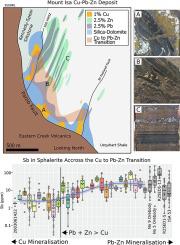当前位置:
X-MOL 学术
›
Ore Geol. Rev.
›
论文详情
Our official English website, www.x-mol.net, welcomes your
feedback! (Note: you will need to create a separate account there.)
Textural and geochemical analysis of chalcopyrite, galena and sphalerite across the Mount Isa Cu to Pb-Zn transition: Implications for a zoned Cu-Pb-Zn system
Ore Geology Reviews ( IF 3.2 ) Pub Date : 2020-09-01 , DOI: 10.1016/j.oregeorev.2020.103647 Bradley Cave , Richard Lilly , Karin Barovich
Ore Geology Reviews ( IF 3.2 ) Pub Date : 2020-09-01 , DOI: 10.1016/j.oregeorev.2020.103647 Bradley Cave , Richard Lilly , Karin Barovich

|
Abstract The genesis of the Mount Isa Cu-Pb-Zn system, northern Australia, is highly debated. Three metallogenic models have previously been proposed to explain the close spatial relationship between a world-class Cu and Pb-Zn deposit: (1) ca. 1650 Ma syngenetic Pb-Zn mineralisation that has been re-mobilised and overprinted by ca. 1520 Ma epigenetic Cu mineralisation; (2) ca. 1650 Ma syn-sedimentary Cu-Pb-Zn mineralisation; (3) ca. 1520 Ma epigenetic Cu-Pb-Zn mineralisation. To assess the viability of these models, detailed petrography and core logging was completed on numerous samples across eight sections of drill core that intersect both Cu and Pb-Zn mineralisation. This was accompanied by the analysis of trace elements in chalcopyrite, galena and sphalerite from various samples across the lateral transition from Cu- to Pb-Zn-rich mineralisation. Across the Cu to Pb-Zn transition there is a primary change in host lithology from Cu-rich silica-dolomite breccia to highly-stratiform Pb-Zn-rich, carbonaceous, carbonate-rich, and fine-grained pyrite-rich shale. Petrography suggests that sphalerite, galena and chalcopyrite co-crystallised, consistently enveloping and/or replacing pre-mineralisation silica-dolomite, siderite, calcite, arsenopyrite, fine- and coarse-grained pyrite. From Cu to Pb-Zn-rich mineralisation, sphalerite and galena transition from micro-inclusions primarily located within coarse-grained chalcopyrite to dominant fine- to coarse-grained components that infill around deformed carbonaceous shale and selectively replace carbonate-rich and fine-grained pyrite-rich shale. Chalcopyrite transitions from a coarse-grained component that replaces silica-dolomite alteration to an uncommon medium- to fine-grained component residing within stratabound Pb-Zn mineralisation. Trace element trends demonstrate that as Pb-Zn mineralisation is approached, the concentrations of Bi in chalcopyrite, Cd, Se, Te, Bi in galena, and Bi and Co in sphalerite decrease, or are relatively depleted. Conversely, the concentrations of Pb in chalcopyrite, Sb in galena, and Pb, Sb and Ag in sphalerite increase, or are relatively enriched. These trends are consistent with a temperature gradient between Cu and Pb-Zn mineralisation during ore emplacement. The sphalerite GGIMFis geothermometer yields a median homogenisation temperature of 343 ± 44 °C, consistent with previous temperature estimates of Cu mineralisation, silica-dolomite formation and chlorite alteration. An epigenetic and coeval Cu-Pb-Zn model is favoured where a slight temperature gradient (
中文翻译:

横跨 Isa 山 Cu 到 Pb-Zn 转变的黄铜矿、方铅矿和闪锌矿的结构和地球化学分析:对分区 Cu-Pb-Zn 系统的影响
摘要 澳大利亚北部 Mount Isa Cu-Pb-Zn 系统的成因备受争议。先前已经提出了三种成矿模型来解释世界级铜和铅锌矿床之间的密切空间关系:(1)大约。1650 Ma 的同生 Pb-Zn 矿化,已被大约重新动员和套印。1520 Ma后生铜矿化;(2) 大约 1650 Ma同沉积Cu-Pb-Zn矿化;(3) 大约 1520 Ma 后生铜铅锌矿化。为了评估这些模型的可行性,在与铜和铅锌矿化相交的八个钻芯部分的大量样本上完成了详细的岩石学和岩心测井。伴随着对黄铜矿中微量元素的分析,方铅矿和闪锌矿从富含铜到铅锌矿化的横向过渡的各种样品。在 Cu 到 Pb-Zn 的转变过程中,主体岩性发生了主要变化,从富含 Cu 的二氧化硅-白云石角砾岩到高度层状的富含 Pb-Zn、碳质、富含碳酸盐和细粒富含黄铁矿的页岩。岩石学表明闪锌矿、方铅矿和黄铜矿共结晶,始终包裹和/或取代矿化前的硅白云石、菱铁矿、方解石、毒砂、细粒和粗粒黄铁矿。从铜到富铅锌矿化,闪锌矿和方铅矿从主要位于粗粒黄铜矿内的微包裹体转变为占主导地位的细粒到粗粒组分,充填变形碳质页岩并选择性地取代富含碳酸盐和细粒富含黄铁矿的页岩。黄铜矿从取代二氧化硅-白云石蚀变的粗粒组分转变为位于层状铅锌矿化中的不常见的中细粒组分。微量元素趋势表明,随着Pb-Zn成矿作用的接近,黄铜矿中的Bi、方铅矿中的Cd、Se、Te、Bi和闪锌矿中的Bi和Co的浓度降低或相对贫化。反之,黄铜矿中的Pb、方铅矿中的Sb、闪锌矿中的Pb、Sb、Ag的浓度增加或相对富集。这些趋势与矿石就位期间 Cu 和 Pb-Zn 矿化之间的温度梯度一致。闪锌矿 GGIMFis 地温计产生的平均均质温度为 343 ± 44 °C,与之前对铜矿化、二氧化硅-白云石形成和绿泥石蚀变的温度估计一致。在轻微的温度梯度(
更新日期:2020-09-01
中文翻译:

横跨 Isa 山 Cu 到 Pb-Zn 转变的黄铜矿、方铅矿和闪锌矿的结构和地球化学分析:对分区 Cu-Pb-Zn 系统的影响
摘要 澳大利亚北部 Mount Isa Cu-Pb-Zn 系统的成因备受争议。先前已经提出了三种成矿模型来解释世界级铜和铅锌矿床之间的密切空间关系:(1)大约。1650 Ma 的同生 Pb-Zn 矿化,已被大约重新动员和套印。1520 Ma后生铜矿化;(2) 大约 1650 Ma同沉积Cu-Pb-Zn矿化;(3) 大约 1520 Ma 后生铜铅锌矿化。为了评估这些模型的可行性,在与铜和铅锌矿化相交的八个钻芯部分的大量样本上完成了详细的岩石学和岩心测井。伴随着对黄铜矿中微量元素的分析,方铅矿和闪锌矿从富含铜到铅锌矿化的横向过渡的各种样品。在 Cu 到 Pb-Zn 的转变过程中,主体岩性发生了主要变化,从富含 Cu 的二氧化硅-白云石角砾岩到高度层状的富含 Pb-Zn、碳质、富含碳酸盐和细粒富含黄铁矿的页岩。岩石学表明闪锌矿、方铅矿和黄铜矿共结晶,始终包裹和/或取代矿化前的硅白云石、菱铁矿、方解石、毒砂、细粒和粗粒黄铁矿。从铜到富铅锌矿化,闪锌矿和方铅矿从主要位于粗粒黄铜矿内的微包裹体转变为占主导地位的细粒到粗粒组分,充填变形碳质页岩并选择性地取代富含碳酸盐和细粒富含黄铁矿的页岩。黄铜矿从取代二氧化硅-白云石蚀变的粗粒组分转变为位于层状铅锌矿化中的不常见的中细粒组分。微量元素趋势表明,随着Pb-Zn成矿作用的接近,黄铜矿中的Bi、方铅矿中的Cd、Se、Te、Bi和闪锌矿中的Bi和Co的浓度降低或相对贫化。反之,黄铜矿中的Pb、方铅矿中的Sb、闪锌矿中的Pb、Sb、Ag的浓度增加或相对富集。这些趋势与矿石就位期间 Cu 和 Pb-Zn 矿化之间的温度梯度一致。闪锌矿 GGIMFis 地温计产生的平均均质温度为 343 ± 44 °C,与之前对铜矿化、二氧化硅-白云石形成和绿泥石蚀变的温度估计一致。在轻微的温度梯度(










































 京公网安备 11010802027423号
京公网安备 11010802027423号